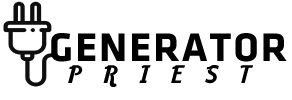What Is a Solar Inverter? Working, Types & Which One is Best For You
In this article, we have explained what is a solar inverter, how it works in simple steps, its types, its cost, and which one is best for you.
The most important part of a solar PV system is a solar inverter which is used to fully maximize solar power. They convert and boost solar energy into a form that can be used by home appliances.
You can use solar power without an inverter, but that power will only be used for DC appliances, and most standard homes use AC appliances. So, an inverter is an absolute necessity for a solar system.
They are different types of solar inverters available on the market, but first, you need to learn how an inverter works, and which type is suitable for your home.
We will help you to understand these things in our article.
Summary of The Article.
What Does A Solar Inverter Do?
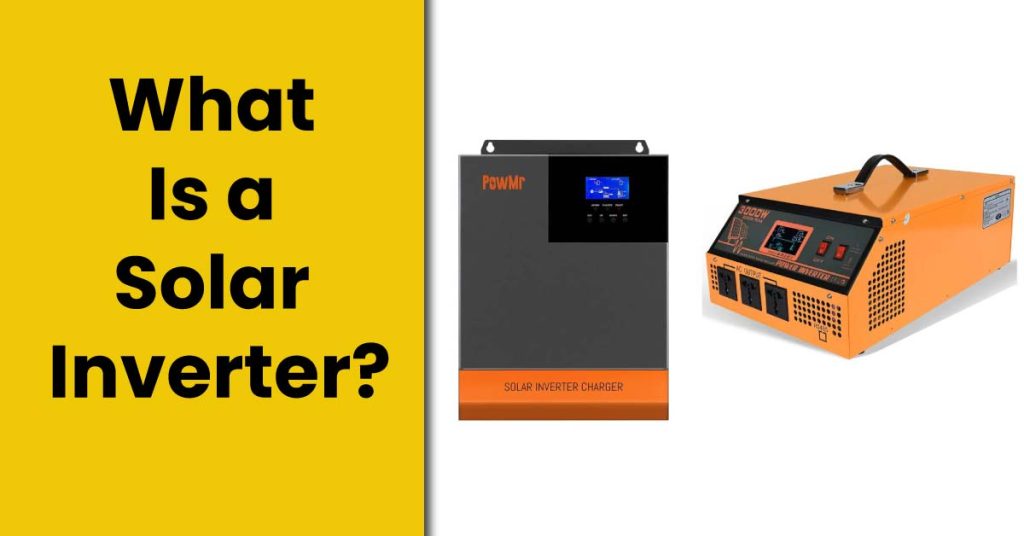
A solar inverter is an electronic device that is used to convert DC (Direct current) power coming from the solar panels into smooth AC (Alternating current) power. Inverters also maximize the power coming from the solar and make sure your solar plant is operating safely by detecting any fluctuations in power to prevent any to your solar, home, and people.
Speaking of inverters, Solar power stations have built-in inverters in them. They are like one stop for all. You can read our reviews on power stations if you are planning to purchase one.
How Does a Solar Inverter Work? Explained in 9 Easy Steps
Being an energy and environmental engineer, sometimes I get carried away and give a bunch of complex information which is hard to understand for an average person. I will explain this topic very simply in steps.
- When the sunlight hit the photovoltaic solar panel, the electrons within the solar cells start to agitate.
- This agitation, moving, or flow of electrons is called current.
- The electrons produce DC (direct current).
- The circuit at the end of your solar panel collects all the DC and sends it to your home.
- Most homes use AC appliances that need AC (alternating current) to operate not DC. So, this is where the solar inverter comes in.
- The job of the solar inverter is to convert the dirty DC power into smooth and sine wave AC power.
- That AC power is as clean and usable as utility grid power.
- Now you can use your solar power for AC appliances too.
- A solar inverter is necessary to power sensitive appliances.
Why Do Households Use AC Power and Not DC Power?
AC (alternating current) power is cheaper to generate and has minimum energy losses compared to DC power. With just a transformer, AC voltage is can convert voltage levels which makes it easier to transport across great distances than DC, whose conversion requires complex and expensive equipment. That is why most of power plants supply AC power.
Types of Solar Inverters
The technician will tell you which type of solar inverter is going to be installed with your solar panels. It depends on multiple factors including the amount of sunlight your home receives. To give you a general idea, the following are different types of solar inverters.
1. String Solar Inverters:
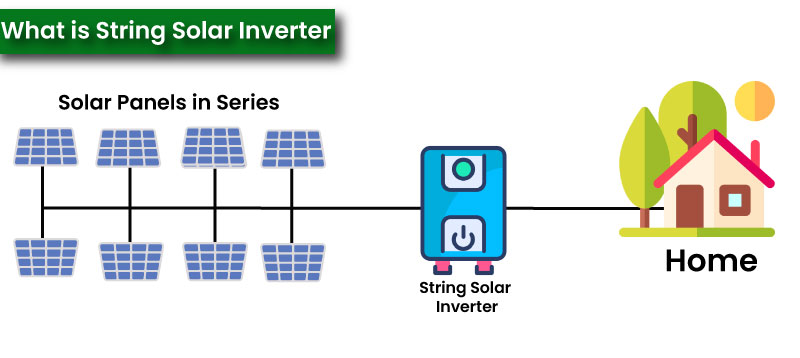
Suppose a string of solar panels is connected/wired together in series which means the voltage is added up as each panel is connected, and all the combined DC power will go to the single solar string inverter which will convert the DC power into DC.
It means a single-string inverter will convert all the DC power coming from solar panels connected in string/series into AC power.
This is the most common and traditional type of solar inverter used in most homes.
Even I use a string inverter with my four 400-watt solar panels connected in a string or series.
Best For: Residential use. Homes with a simple and uncomplicated roof that receive plenty of sunlight throughout the day. It is a budget-friendly solar PV system.
Advantages of a String Solar Inverter
- A single inverter is used to convert all the DC power into AC.
- It is a budget-friendly and cost-effective inverter option.
- They are easy to access and maintain.
Disadvantages of a String Inverter
- Suppose one of eight solar panels is working at only 80%, then the whole string of panels will work at only 80%.
- If one panel is not working properly, then the whole string will suffer the same fate.
3. MicroInverters:
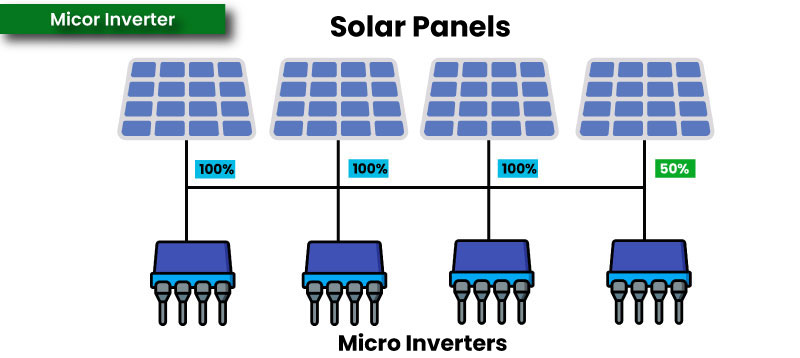
In simple words, one microinverter per panel.
Suppose you have 8 solar panels on your roof, then you will have to install one micro-inverter per panel. A micro inverter will convert DC power into AC per panel.
You will have 240V AC power coming down into the home. A string of solar panels is not needed in this setup.
The microinverter will change the voltage to 240VAC at each solar panel, and then all eight of them are wired in parallel.
Each panel is a separate entity not responsible for other panels. The installation is not complex and you don’t need to have an uncomplicated roof for the installation. Just find a spot with plenty of sunlight for the panel with the microinverter.
A study conducted at the University of Virginia found micro inverters are 27% more efficient than string inverters for shaded solar installations.
Best For: For solar plants facing sunlight from multiple directions. For homeowners who want to maximize solar energy products in a small roof or space, and properties or buildings with complicated roofs.
Advantages of Microinverters
- Each panel works completely independently from the other. Each panel is monitored separately.
- If one of the panels is not working at 100% for any reason, the rest of the panels with micro inverters will continue to work at their maximum power.
- With micro inverters, we don’t need to worry about orientation or shading like string inverters.
Disadvantages of Micro Inverters
- Micro inverters cost more to install compared to string inverters
- They are difficult to maintain and repair because they are located on the roof along with the panel.
3. Solar Power Optimizers:
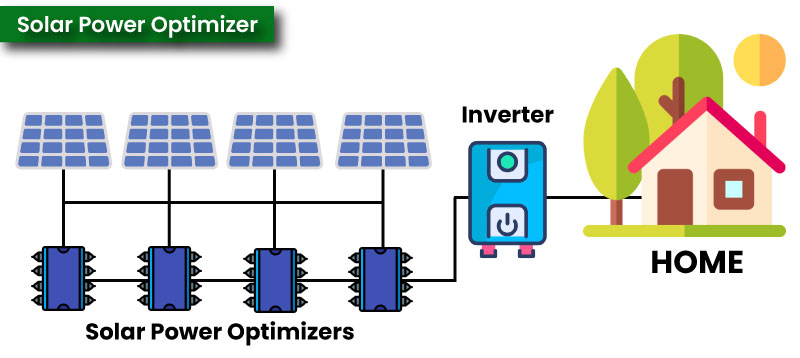
A solar power optimizer is a maximum power point tracking (MPPT device for each solar panel.
Power optimizer takes the DC power generated by solar panels, optimizes it using MPPT technology, and then sends that DC power to the inverter in your home.
They can either be installed near the solar panel, or they can be integrated into the solar panel itself inside the junction box.
A solar power optimizer manages the power of each solar panel independently like micro inverters. So, if one panel is not performing as it should for any reason, it will affect the rest of the production.
Best For: Homeowners with less-than-ideal rooftops. It is ideal for every solar system honestly.
Advantages of Solar Power Optimizers
- The main advantage solar optimizer has over micro inverters is it doesn’t require special cables and connectors.
- Maintenance cost after the initial cost is also less.
- Optimizers cost less than micro inverters and they can be used with panels over 250 watts of capacity.
- Micro inverters can only be used up to 250-watt panels.
Disadvantages of Solar Power Optimizers:
- Solar optimizers can last up to 25 years but inverters have a maximum lifespan of 10 years. You will need to replace the inverter down the road.

Alex Black is a seasoned electrical engineer with a remarkable 8-year track record specializing in appliances, generators, and transfer switches. With extensive hands-on experience in the field, Alex possesses a deep understanding of electrical systems and their intricate workings. Throughout their career, Alex has consistently demonstrated expertise in designing, troubleshooting, and maintaining various electrical appliances.
